Highly prized for their lustrous array of colors, and farmed in partnership with local communities, Fiji pearls are unique in the world of precious gems.
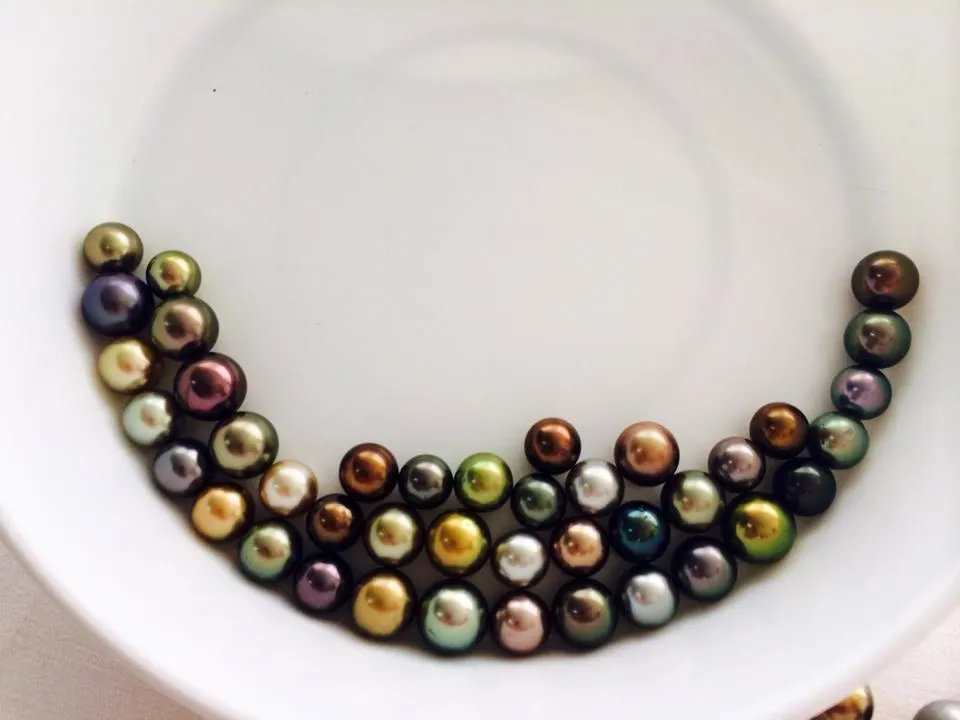
Fiji pearls are prized for their beautiful colors
Out of the hundreds of thousands of visitors to Fiji each year, only about 20,000 or so make it to lovely little Savusavu, a town of less than 5,000 on Fiji’s second largest island of Vanua Levu. If Savusavu is “Fiji’s best kept secret,” the opportunity to visit J. Hunter Pearls and see how Fiji pearls are farmed right in Savusavu Bay is another.
J. Hunter Pearls is a recent success story in the world of Fiji pearls. Since the 1960’s, Japanese pearl farmers have had a small presence in Fiji. In 1999, marine biologist Justin Hunter returned from the United States to his hometown of Savusavu with innovative new ideas on how to resurrect and grow the pearl farming industry in Fiji. Justin’s vision was to enlist local village residents as partners in order to maintain the unspoiled natural environment and create economic opportunity.
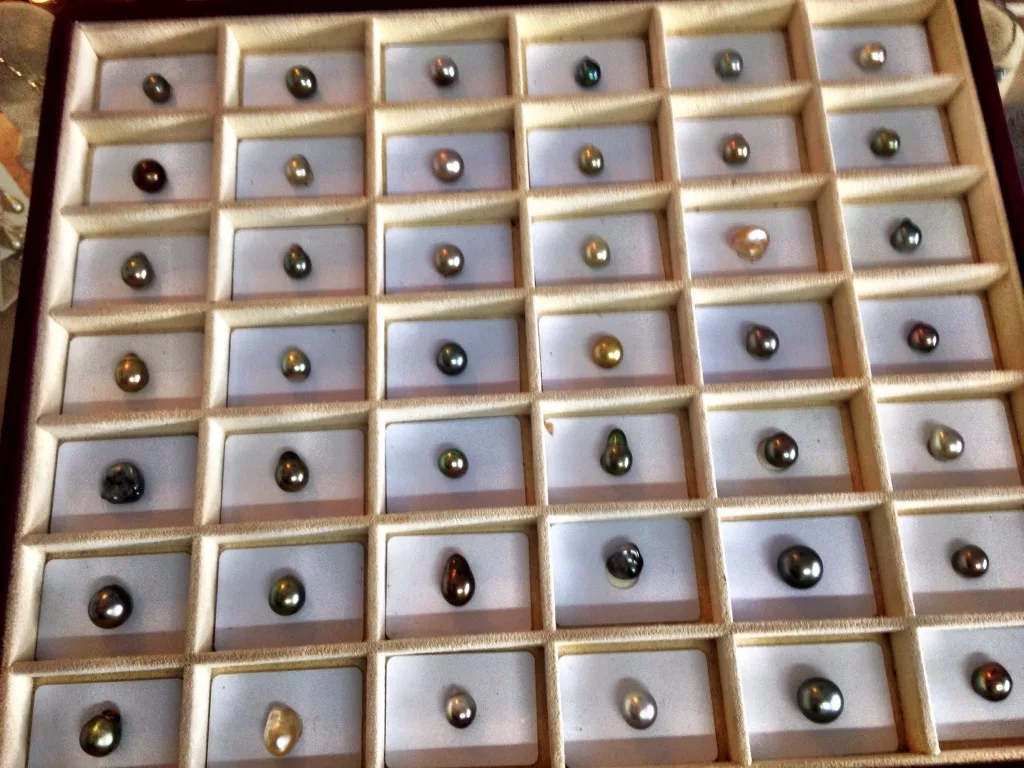
Different colors on display at J. Hunter Pearls
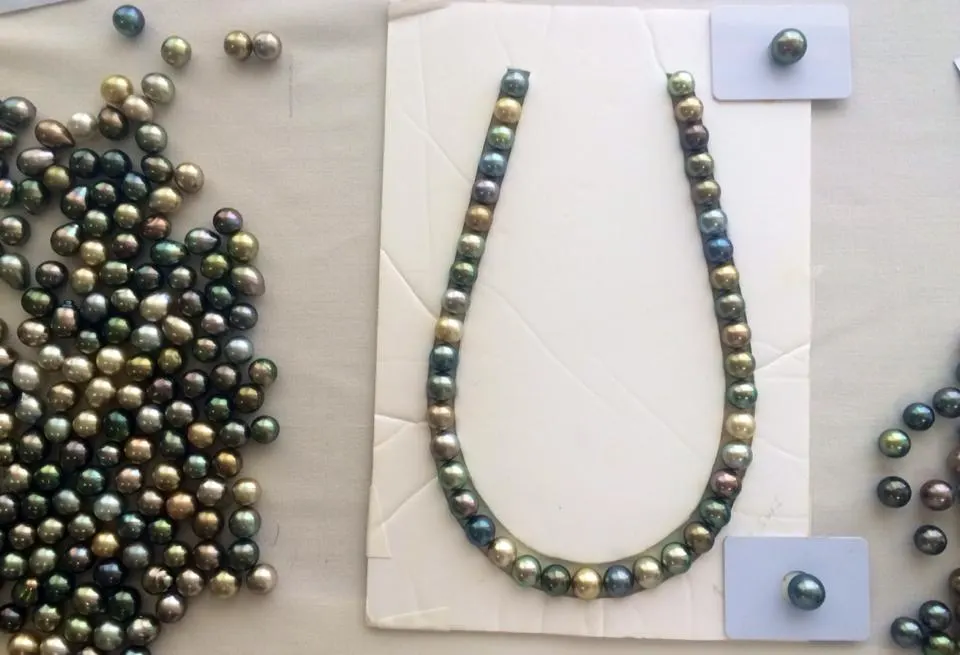
Stringing a multi-colored necklace Photo Credit: J. Hunter Pearls
Nowadays, J. Hunter Pearls leases from fishing rights owners, employs local workers to clean and harvest, and provides scholarships to deserving students as part of its community partner status. Additionally, the company abides by a strict environmental code of practice which has helped increase fish populations in the bay, adding local economic benefit. This video from four years ago gives an overview:
J. Hunter Pearls is located in an unassuming building across from their small pier on Savusavu Bay, with the main pearl farm located straight out from the pier.
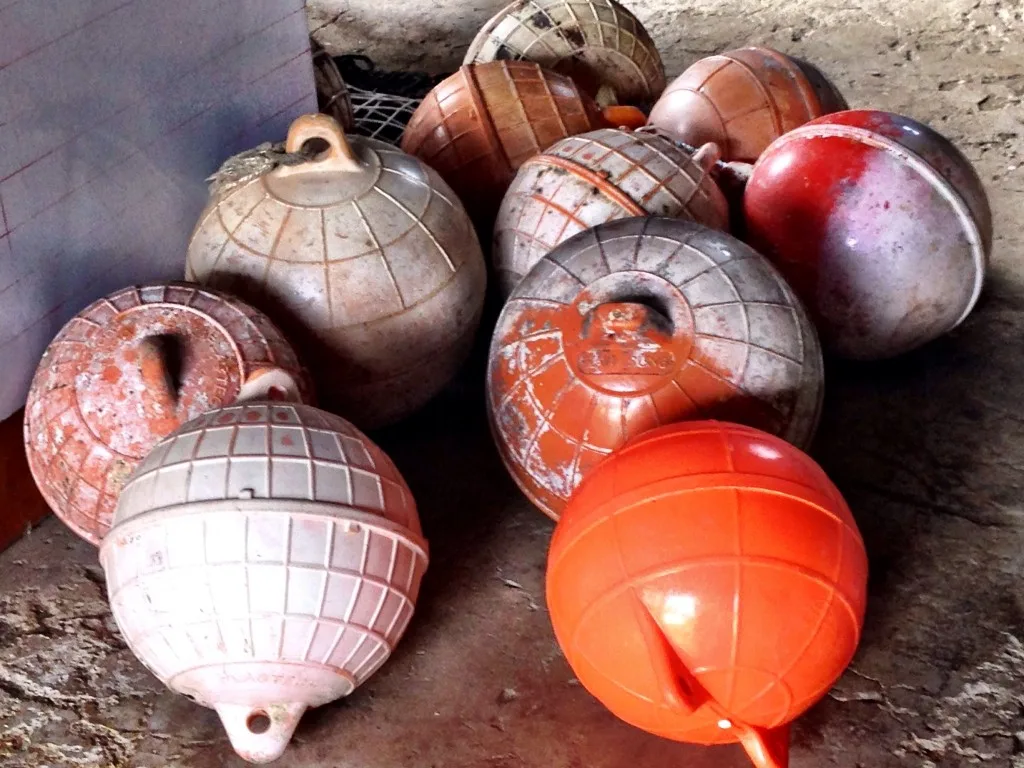
Buoys piled in the warehouse
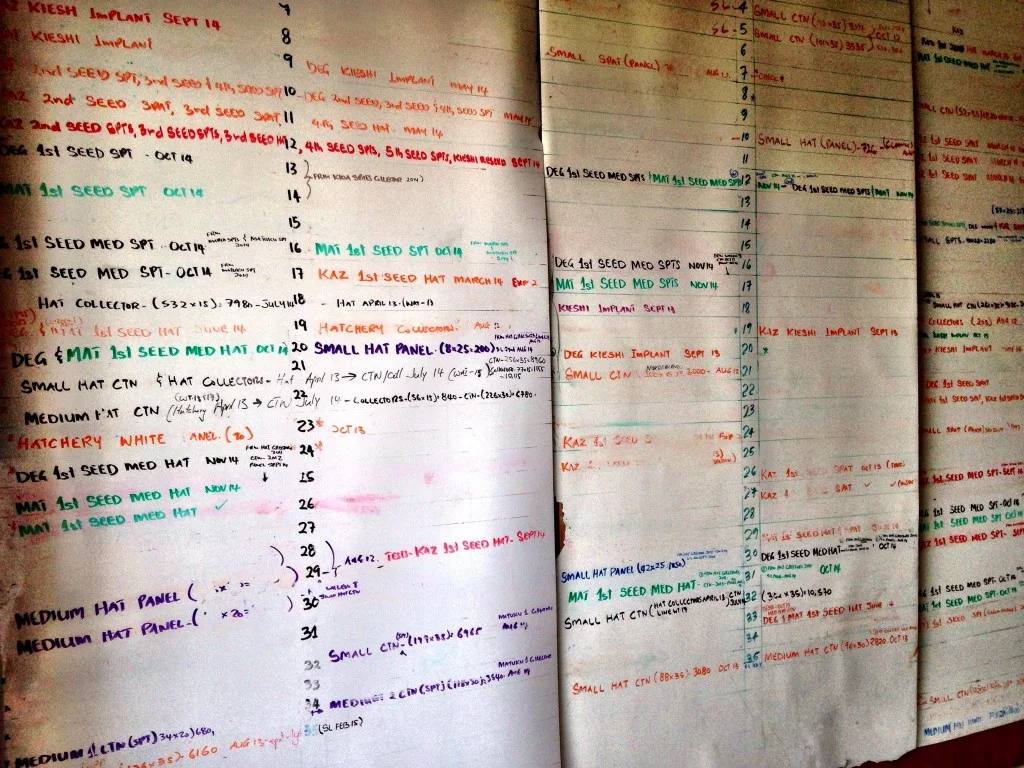
Schedule board in warehouse keeps track of production
We were treated to a comprehensive presentation and then shuttled out in a small skiff to the farm. In the middle of Savusavu Bay, workers were cleaning and inspecting oysters amidst the buoys that marked their growing cages.
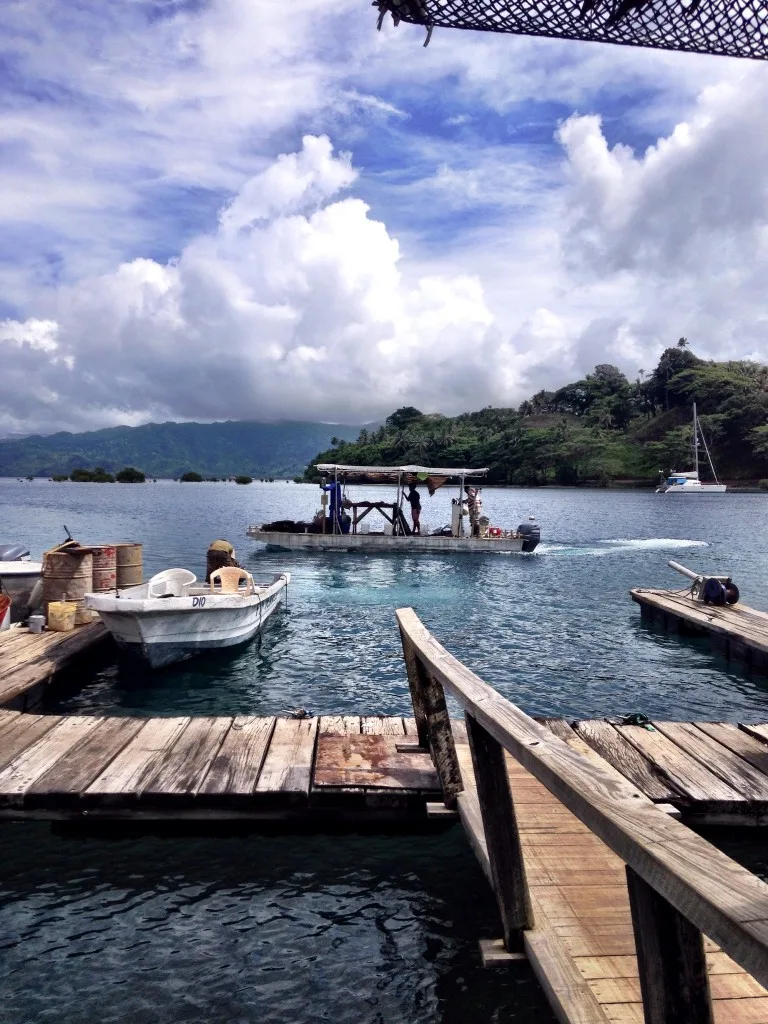
Pearl farm workers on their way
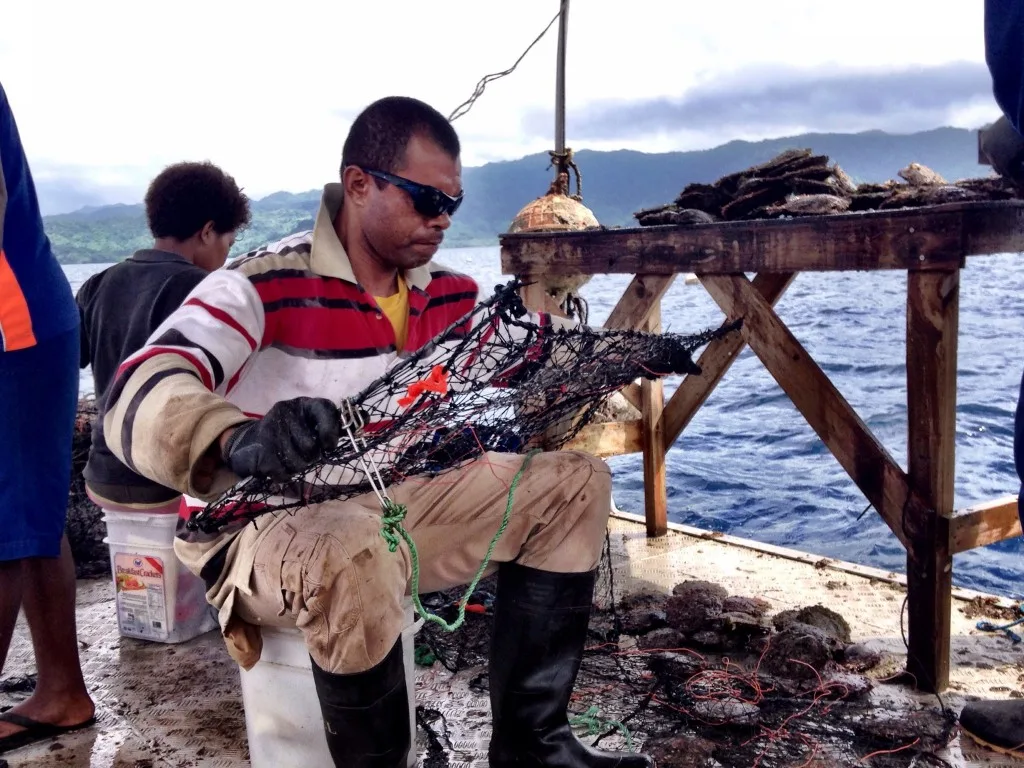
Extracting the oysters from their netted cages
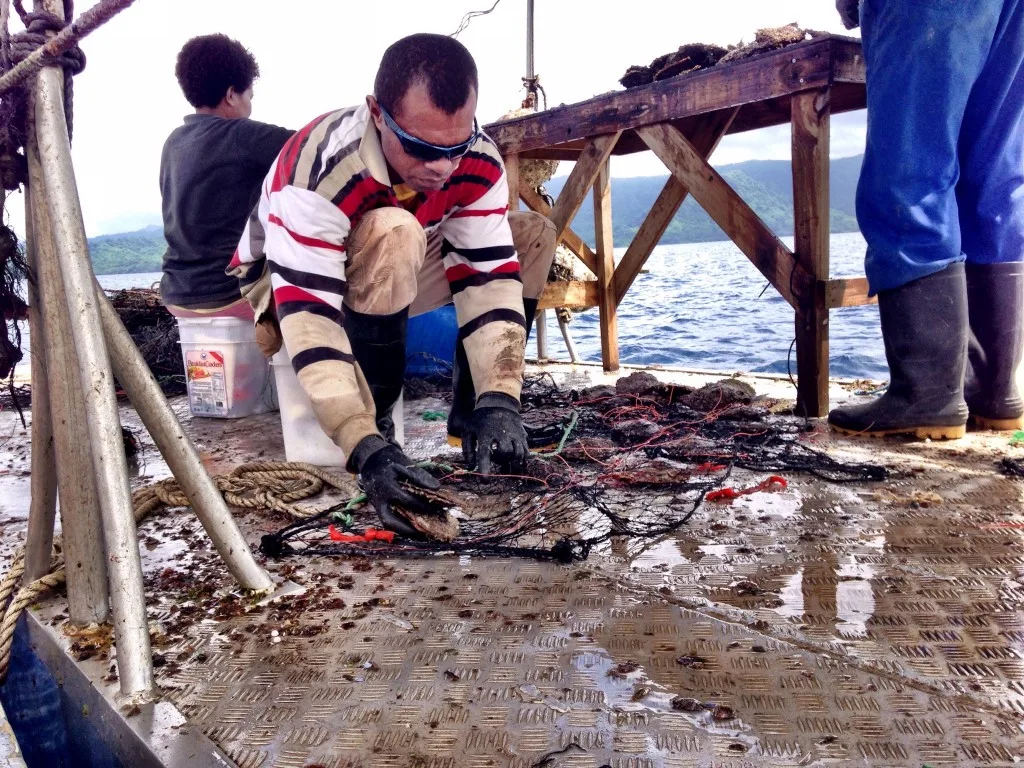
Cleaning barnacles from the oysters by hand – you can see rejected white beads on the flooring

Rough work on hands – different colored string identifies growth stages
It was at this point in our visit that we began to realize why Fiji pearls are so expensive. Not only is their color variety so unique, but the hands-on, organic aspects of their cultivation and care add to their overall finished value.
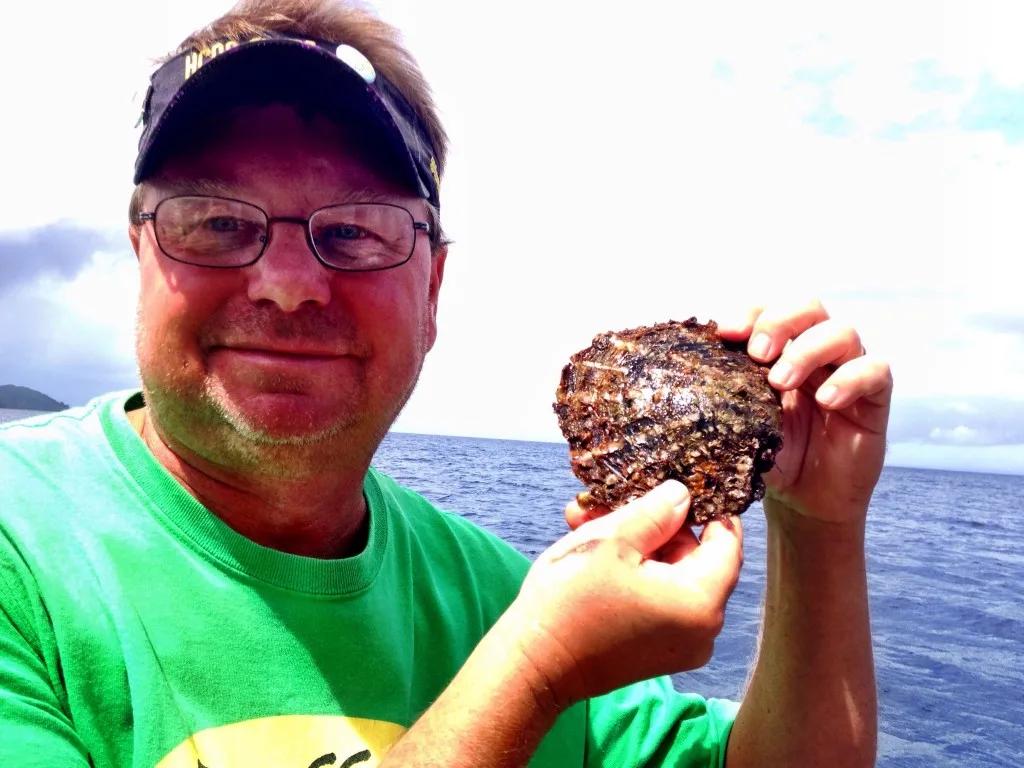
Pete holds a mature oyster
Fiji pearls still have a Japanese connection: J. Hunter Pearls employs expert technicians who come from Japan to implant the oysters with small beads (which interestingly, come from the Mississippi River). The oyster then forms the pearl around the bead, which it views as an irritant, by secreting lining material around it. The color of the pearl is determined by the color of the lining just inside the black lip of the oyster. The entire process takes about 18 months, and a producing oyster can yield 3-4 pearls on average through its lifespan.
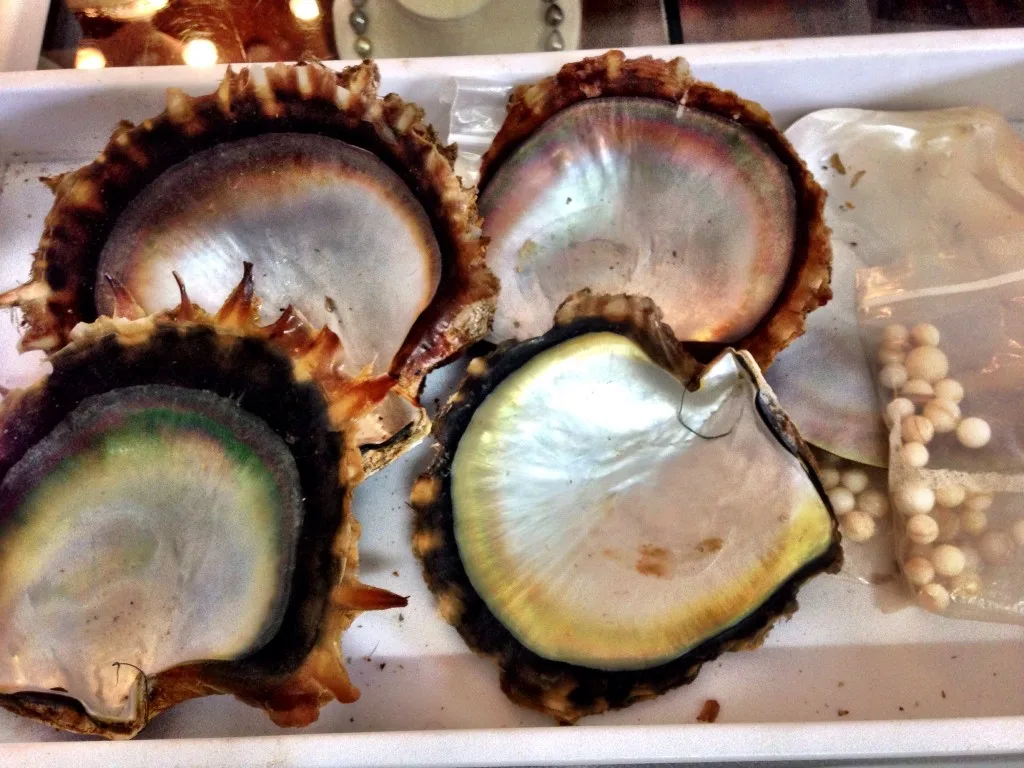
Different linings produce different colored pearls, formed around the inserted white bead
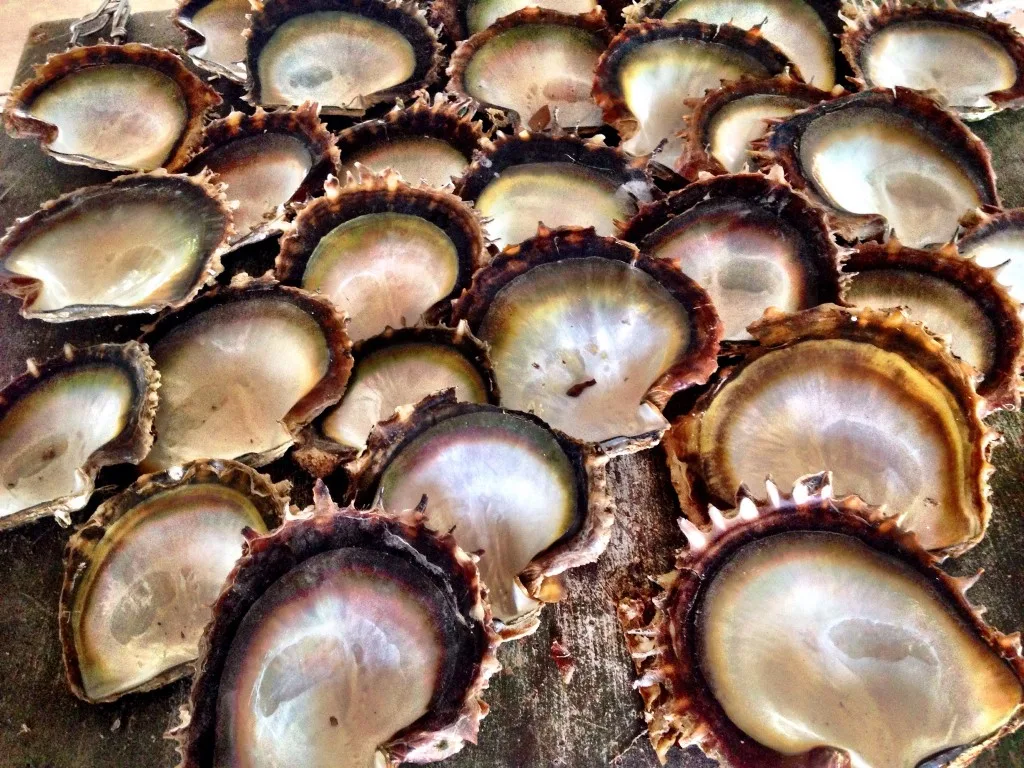
Oyster shells post-harvest – imagine the color of the pearl from each one!
The oyster may reject the bead, resulting in no pearl. The oyster may also grow a pearl which has no nucleus, called a keshi pearl. Fiji pearls can be single color or variegated and striated. J. Hunter Pearls come in two different color palettes: warm – champagne, chocolate, copper, cranberry, gold and pistachio, and cool – deep blues and greens. Overtones can include coppery-gold, deep sapphire, dusty rose and turquoise. All are stunningly beautiful.
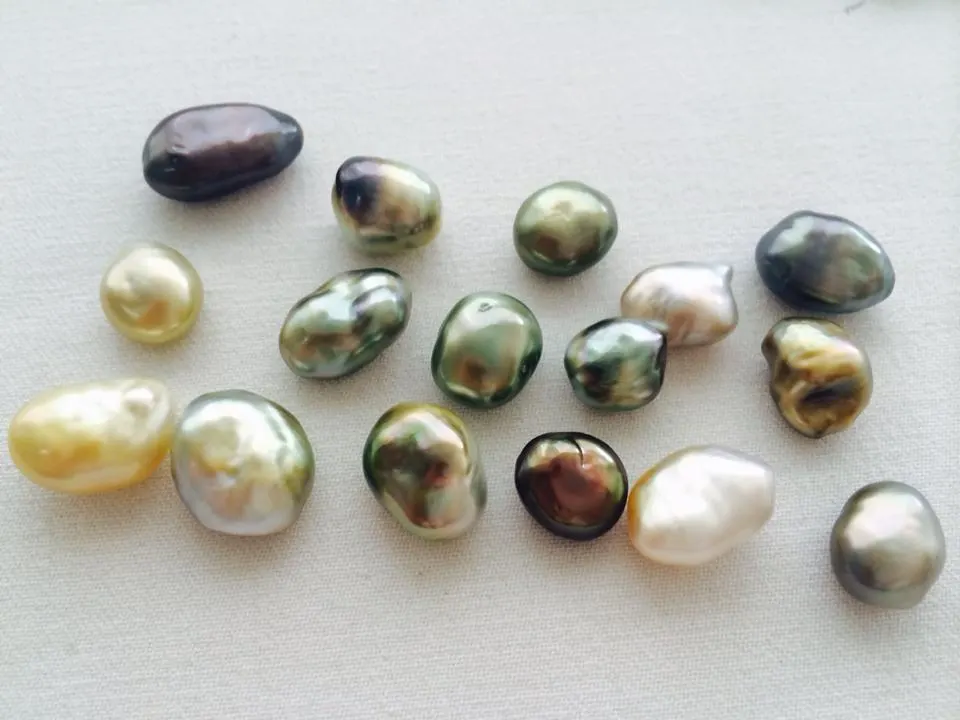
Keshi pearls – Photo Credit: J. Hunter Pearls
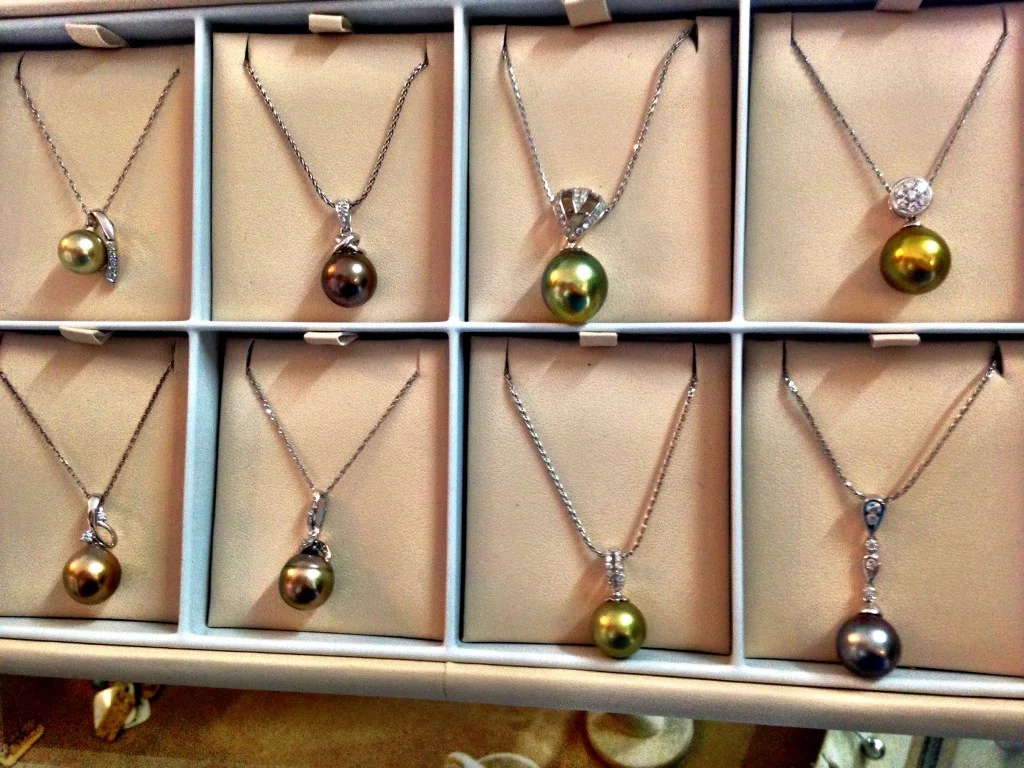
J. Hunter Pearls uses white and yellow gold settings with diamonds to enhance individual pendants
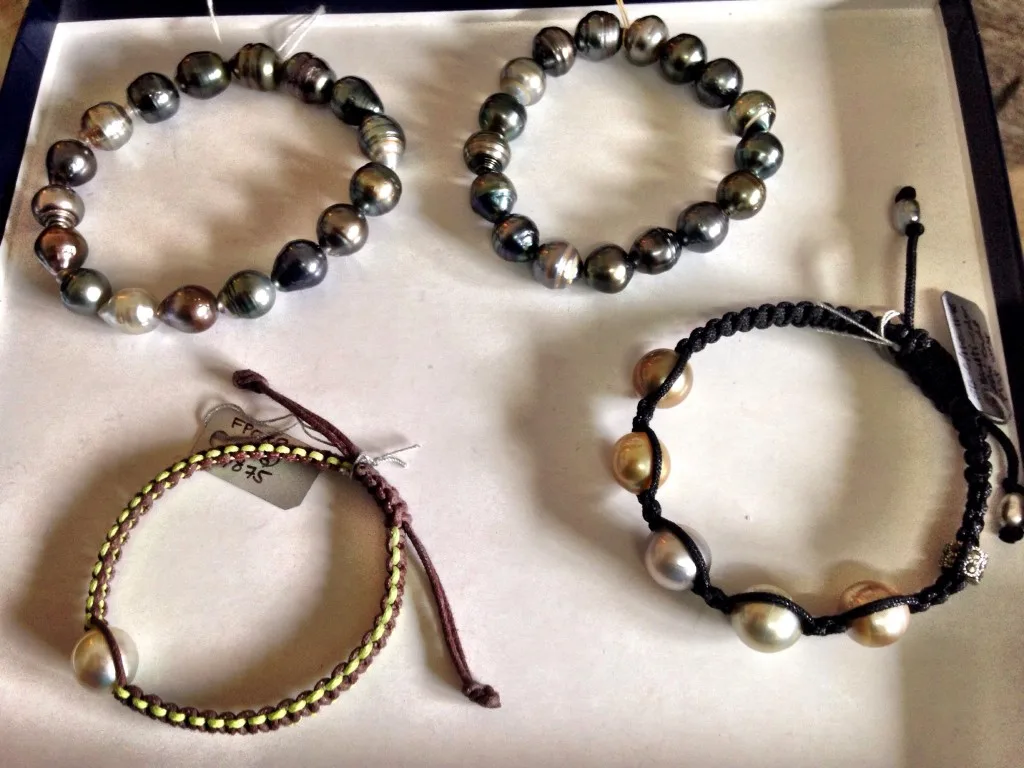
Multiple pearl bracelets often combine colors
Pearl farming isn’t without its hazards. Young oysters are fragile and prone to predators. As well, just as with land farming, natural disasters such as cyclones or environmental anomalies threaten yields. This video from three years ago shows the effects and aftermath of a cyclone.
Fiji pearls are in high demand in European markets, most notably Austria, Switzerland and Germany. J. Hunter Pearls currently exports about 70-80% of its pearls to European partners, and would like to expand in other markets.
Back in the showroom, we oohed and ahhed over the Fiji pearls which had been crafted into a variety of stunning jewelry pieces. Necklaces, bracelets, rings and earrings were tempting, as well as carved mother of pearl pieces made from the shells.
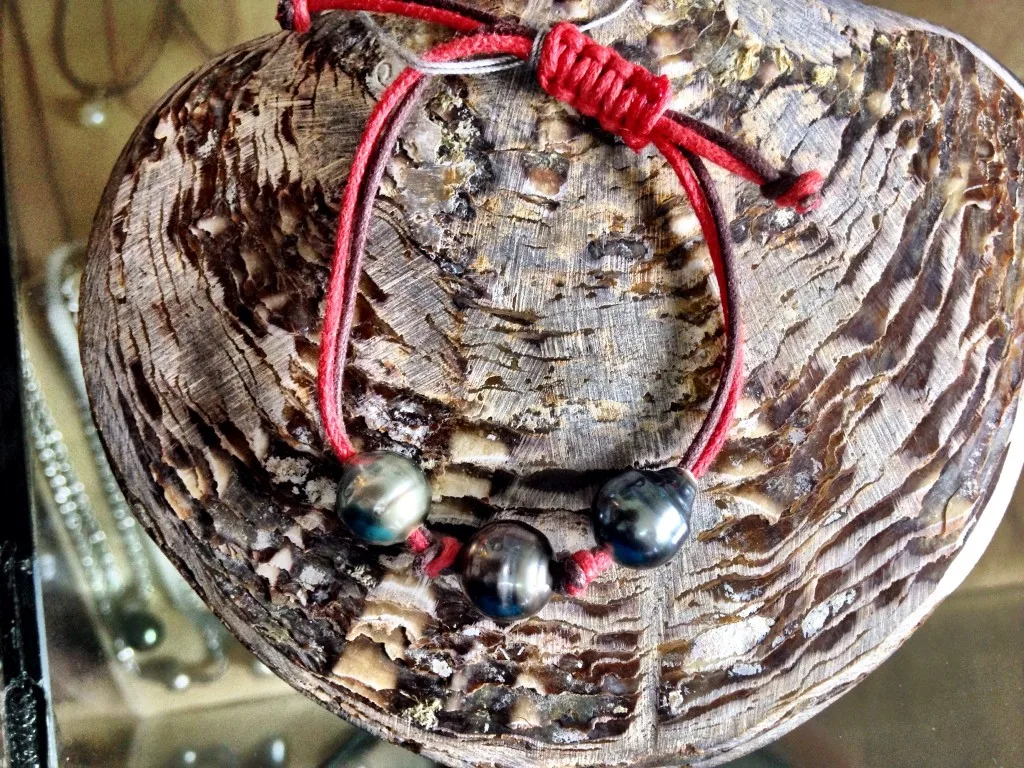
Leather bracelet with three pearls
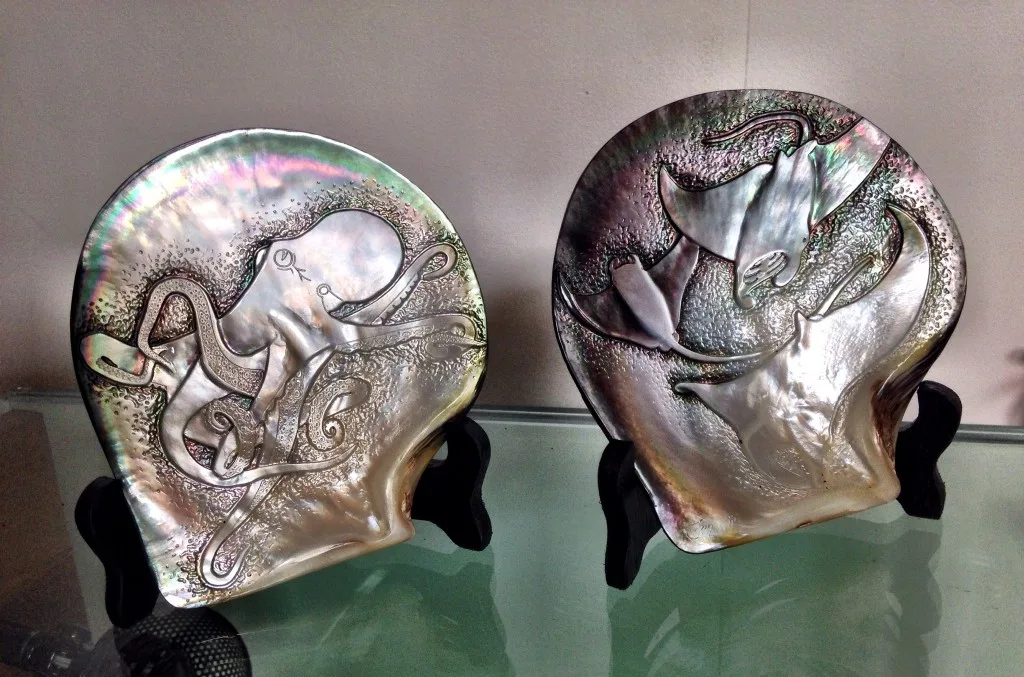
Mother of Pearl carvings
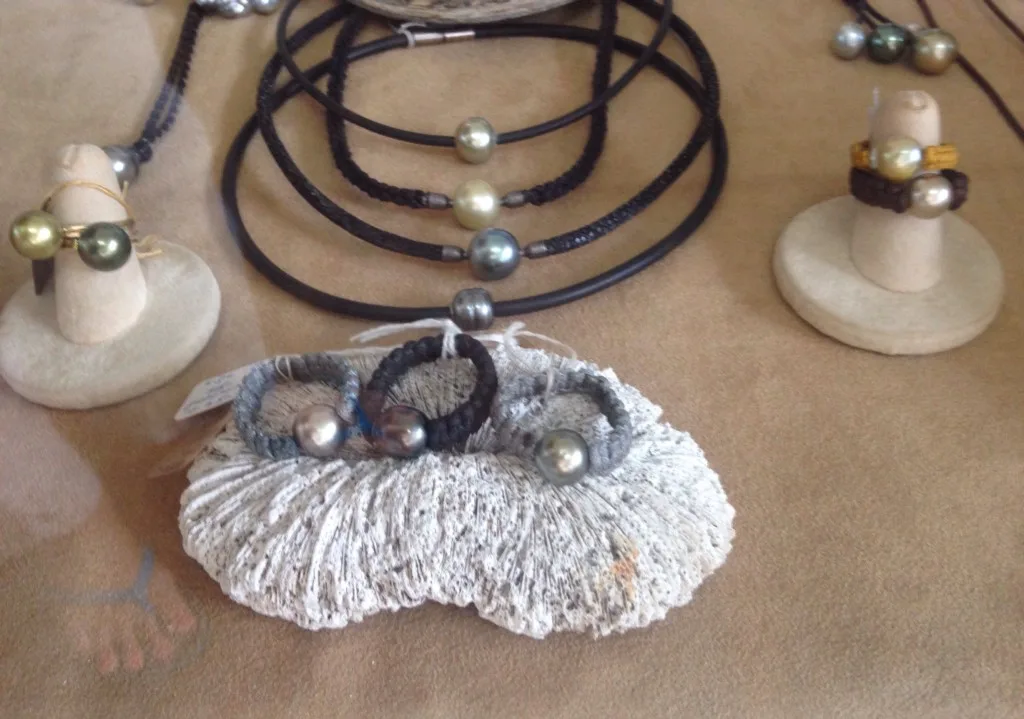
Rings and pretty things
Changes are afoot in Savusavu Bay with the approval of a high-end resort project on the foreign investor-owned island adjacent to where the pearl farm is currently located. Of concern is the potential environmental impact the project will have which may disturb the fragile ecosystem the oysters require. We felt fortunate to have visited prior to any real work being done on this project. Sweet little Savusavu will be a different place once it has been completed. All the same, we plan to visit again, and you should, too, for a glimpse of the real Fiji and real Fiji pearls.
Tips for Trip Success
Book Your Flight
Find an inexpensive flight by using Kayak, a favorite of ours because it regularly returns less expensive flight options from a variety of airlines.
Book Your Hotel or Special Accommodation
We are big fans of Booking.com. We like their review system and photos. If we want to see more reviews and additional booking options, we go to Expedia.
You Need Travel Insurance!
Good travel insurance means having total peace of mind. Travel insurance protects you when your medical insurance often will not and better than what you get from your credit card. It will provide comprehensive coverage should you need medical treatment or return to the United States, compensation for trip interruption, baggage loss, and other situations.Find the Perfect Insurance Plan for Your Trip
PassingThru is a participant in the Amazon Services LLC Associates Program. As an Amazon Associate I earn from qualifying purchases.
To view PassingThru’s privacy policy, click here.

donna-may
Wednesday 3rd of February 2016
Hi there.... I was wondering where one might buy the pearl bracelets with cord on this page.
Thank you so much!
Donna-May
Betsy Wuebker
Wednesday 3rd of February 2016
Hi Donna-May - J. Hunter Pearls website: http://www.fijipearls.com/jewellery/
Cath
Friday 13th of February 2015
This was really interesting. I had no idea that pearls came in so many different colours.
Betsy Wuebker
Friday 13th of February 2015
Hi Cath - Neither did I. They are absolutely gorgeous.
Savusavu: Fiji's Hidden Paradise - Passing Thru
Monday 22nd of December 2014
[…] Fiji Pearls: Alluring Gems from Paradise […]
Johanna
Saturday 13th of December 2014
Gosh, what some beautiful colours. It's a hard tough life being a pearl farmer or engaged in pearl farming - we have some in NW Australia near Broome. Fascinating to watch the process, even lovelier to buy the pearls ;)
Betsy Wuebker
Sunday 14th of December 2014
Hi Jo - Yes, indeed, Fiji pearls are standouts, and part of that is that they're so fragile and difficult to grow. :)
Carole Terwilliger Meyers
Friday 12th of December 2014
The Fiji pearls come in almost a rainbow of colors. I was amazed when I saw them. When I visit again, I plan to buy that 3-pearl leather bracelet. :)
Betsy Wuebker
Friday 12th of December 2014
Hi Carole - I was surprised to see and really liked the more casual feel of the leather bracelets and rings.